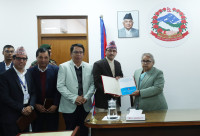National
Heavy to very heavy rainfall likely in Lumbini and Sudurpaschim
Met office issues red alerts in six districts of Sudurpaschim Province, Bardiya of Lumbini, and Surkhet of Karnali Province.
Post Report
The Department of Hydrology and Meteorology has forecast extremely heavy rainfall in some places until Saturday morning.
Issuing a ‘monsoon special bulletin’ on Wednesday, the Met office said that even if the monsoon trough is positioned further south than the average place, there is a chance of a low-pressure area around Madhya Pradesh of India intensifying into a depression and coming close to Nepal, which will cause rainfall.
The Met office said that many places in Gandaki, Lumbini, Karnali and Sudurpaschim provinces would witness light to moderate rainfall, and some places in Sudurpaschim and Lumbini provinces could see very heavy rainfall.
“There is a chance of extremely heavy rainfall in one or two places of Sudurpaschim and Lumbini provinces,” reads the special bulletin.
Red alerts have been issued in Kailali, Kanchanpur, Dadeldhura, Doti, Baitadi and Achham districts of Sudurpaschim province, Bardiya of Lumbini, and Surkhet of Karnali province.
According to Met officials, a red warning means looming extreme weather conditions. Excessive rainfall, floods, landslides, and inundation will likely cause widespread damage. For the general public, it is a message to keep themselves and others safe from the extreme weather consequences and not to travel in risky zones.
An orange alert has been issued in Bara and Parsa of Madhesh Province; Chitwan of Bagmati; Nawalparasi East, Syangja and Tanahun of Gandaki; Arghakhanchi, Rupandehi, Palpa, Kapilvastu, Nawalparasi West, Dang and Banke districts of Lumbini; Dailekh, Kalikot and Salyan of Karnali; and Darchula, Bajhang and Bajura of Sudurpaschim Province.
An orange warning also means moderate risks. Experts say severe situations due to extreme weather events are very likely in the districts. For the general public, it is a message to prepare plans for potential emergencies. As the probability of extreme weather events is high, people are also requested not to travel in risky zones—landslide-prone areas and riverbanks, among others. According to Pradhananga, it is also a request to people to protect themselves and family members.
The department has cautioned the public about risks of land erosion, debris flow and inundation in urban areas and in the Tarai.
The department warns that water level will increase in big as well as small rivers and streams.
“Everyday life, agriculture, health, tourism, road and air transport could also be affected,” the bulletin stated.
The monsoon season in Nepal generally begins on June 13 and ends on September 23. This year, the monsoon entered Nepal from the southwest on June 10, three days ahead of the usual onset date. Last year, it started on June 14, a day prior to the normal onset day.
The monsoon season, which delivers around 80 percent of the country’s total annual rainfall, generally lasts for 105 days. But, in recent years, it has been taking more time to withdraw.
The Met office has forecast above-normal rains and above-average maximum and minimum temperatures this monsoon, which could unleash extreme weather events, such as flooding, inundation and landslides.
The department’s climate section has issued a weather forecast for four months, from June to September. It said most parts of the country are likely to experience above-average minimum and maximum temperatures and rainfall due to weakened El Niño conditions and the development of La Niña conditions.
El Niño refers to climatic patterns in which ocean surface temperatures warm unusually. La Niña is the opposite, in which the ocean surface cools off.
Nepal is one of the world’s most vulnerable countries to the climate crisis and has witnessed multiple extreme weather events over the past decade and a half.
Evidence suggests that maximum temperatures in Nepal are rising faster, at 0.056 degrees Celsius a year, compared to the global average rise of 0.03 degrees Celsius a year.
Experts say extreme weather events—excessive rainfall in a short period, continuous rains for several days after the monsoon, dry spells, droughts, below-average precipitation, and above-normal winter temperatures—have become more frequent in Nepal.




 13.12°C Kathmandu
13.12°C Kathmandu













